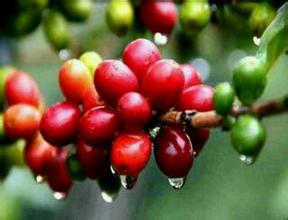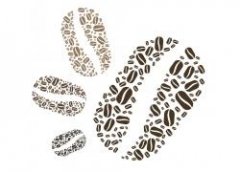Brief introduction to Geographic location, Climate and altitude of Yega Xuefei Sun-cured G1 Coffee

Coffee trees are mostly planted in farmers' own backyard or mixed with other crops in the field, the yield per household is not much, it is a typical rural coffee. Yega Xuefei won the prize beans almost from the above-mentioned coffee villages and communities.
The so-called "Yega Chuefei" refers to the strong aromas of jasmine, lemon or lime acid, as well as peach, almond or tea. On the other hand, the smell of dried blueberries is particularly prominent this season, and the room is full of blueberries after grinding.
Kochel is in the Yejia Sheffield region of southern Ethiopia, but it is said to be one of the highest coffee-growing places on earth. Due to the high altitude, wild native species of coffee, and iron-rich soil, the Cochel community is a very good quality coffee in Yejia Sheffield. It has active citrus acid, floral aroma and sweet silky taste. Coupled with Yejia Sheffield's famous spice and complex fruit flavor, Kochel has become a rare Yega coffee. The cherries they harvest will first be manually screened by small farmers in the nearby community. Coffee trees are mostly old vines, which is the classic flavor of Ethiopian native species.
Country: Ethiopia
Grade: G1
Production area: Kochere
Altitude: 1800 to 2000m
Treatment: insolation
Variety: Heirloom
Soil characteristics: volcanic laterite
Flavor: peach, honey, citrus sugar
Dry fragrance: clean and delicate aroma, floral aroma, vanilla, peach, honey, sugar
Wet fragrance: vanilla plants, peaches, peaches, flowers, citrus
Although the Ethiopian Yirgacheffe coffee is petite, it is gentle and delicate and sweet. As the hometown of coffee, thousands of years of planting history and processing tradition in Ethiopia have created high-quality washed Arabica beans. Light baked with unique sweet aromas of lemon, flowers and honey, soft acidity and citrus flavors, fresh and bright on the palate. No milk or sugar, let the rich texture and unique soft flower scent brush your taste buds, leaving an endless aftertaste.
Planting:
Coffee trees are mostly planted in farmers' own backyard or mixed with other crops in the field, the yield per household is not much, it is a typical rural coffee. These mountain villages are foggy, like spring all year round, with a gentle breeze in summer, cool but not hot, rain but not damp, and no cold damage in winter, giving birth to a unique regional flavor of citrus and flowers.
Taste:
The so-called "Yejia Snow Flavor" refers to the strong aromas of jasmine, lemon, peach, almond and tea. Tasting experience has only one sentence: coffee entrance, flowers in full bloom! Just like a flower touches the comfort of taste buds and olfactory cells in the nasal cavity. In addition to the fragrance of flowers, the delicate mellow thickness (body) is like silk massage in the mouth, and the touch is wonderful. Yega snow caffeine uses the oldest sun treatment. But in 1972, Ethiopia introduced Central and South American water washing technology to improve its quality, which made the jasmine and citrus fragrance of Yega snow coffee more clear and refined, and became the best quality beans in the world. The exquisite washing technology played an important role in water washing after the 1970s. However, in the past two years, Yega Xuefen has been out of the ordinary and launched amazing sun beans frequently! There is a strict standard for collecting red fruits (as a result of coffee trees). Before exposure to coffee fruits, unripe green fruits or defective fruits are removed manually, and damaged or moldy fruits are removed during the sun drying process. after two weeks, the sugar and essence of the flesh and essence seep into the coffee beans, the water content is reduced to 12%, and then scrape the hardened pulp, pectin layer and pods with a planer. Take out the coffee beans and test the density and color of the beans. After eliminating the defective beans, the workers finally picked out the defective beans with the naked eye and screened them layer by layer, resulting in the cleanliness and vulgarity of Yejia snow caffeine sun-dried beans with a strong attractive fruit aroma.
Yejassefi's coffee trees were planted by European monks (a bit like Belgian monks growing wheat to brew beer) and were later transferred to farmers or cooperatives. Yejia Chuefei is actually constructed by surrounding coffee communities or cooperatives, including Edido Idido, Hafusa Harfusa, Hama Hama and Biloya near Fog Valley Misty valley, all washed with water, but there are also a small number of off-product beans engraved with sun to enhance the charming fruit aroma and mellow thickness. These mountain villages are foggy, like spring all year round, with a gentle breeze in summer, cool but not hot, rain but not damp, and no cold damage in winter, giving birth to a unique regional flavor of citrus and flowers.
Important Notice :
前街咖啡 FrontStreet Coffee has moved to new addredd:
FrontStreet Coffee Address: 315,Donghua East Road,GuangZhou
Tel:020 38364473
- Prev

A brief introduction to the fresh and bright Ethiopian sun Yega Shifeiwaka coffee variety planting market price
As the hometown of coffee, thousands of years of planting history and processing tradition in Ethiopia have created high-quality washed Arabica beans. Light baking has unique sweet aromas of lemon, flowers and honey, soft acidity and citrus flavors, fresh and bright on the palate. No milk or sugar, let the rich texture and unique soft scent of flowers brush your taste buds, leaving an endless aftertaste
- Next

A brief introduction to the treatment method of Grinding scale and Baking degree of Fruit-flavored Coffee
These mountain villages are foggy, like spring all year round, with a gentle breeze in summer, cool but not hot, rain but not damp, and no cold damage in winter, giving birth to a unique regional flavor of citrus and flowers. Coffee trees are mostly planted in farmers' own backyards or mixed with other crops in the fields. Yega Xuefei is a by-product area of Sidamo province in Sidamo, Ethiopia, which is located in the northwest of Sidamo.
Related
- Detailed explanation of Jadeite planting Land in Panamanian Jadeite Manor introduction to the grading system of Jadeite competitive bidding, Red bid, Green bid and Rose Summer
- Story of Coffee planting in Brenka region of Costa Rica Stonehenge Manor anaerobic heavy honey treatment of flavor mouth
- What's on the barrel of Blue Mountain Coffee beans?
- Can American coffee also pull flowers? How to use hot American style to pull out a good-looking pattern?
- Can you make a cold extract with coffee beans? What is the right proportion for cold-extracted coffee formula?
- Indonesian PWN Gold Mandrine Coffee Origin Features Flavor How to Chong? Mandolin coffee is American.
- A brief introduction to the flavor characteristics of Brazilian yellow bourbon coffee beans
- What is the effect of different water quality on the flavor of cold-extracted coffee? What kind of water is best for brewing coffee?
- Why do you think of Rose Summer whenever you mention Panamanian coffee?
- Introduction to the characteristics of authentic blue mountain coffee bean producing areas? What is the CIB Coffee Authority in Jamaica?

